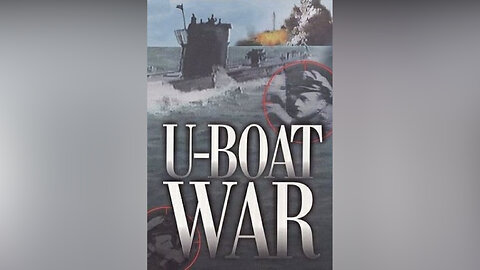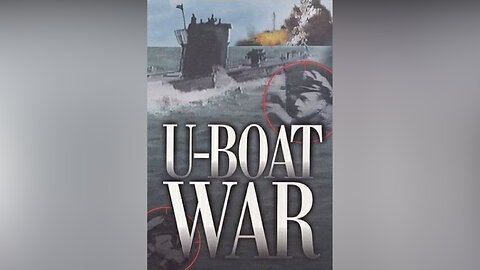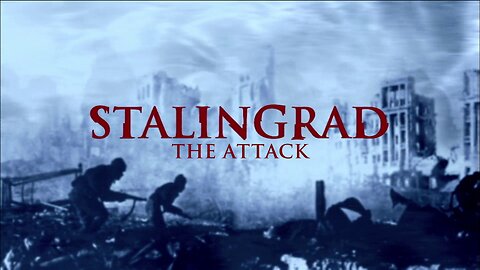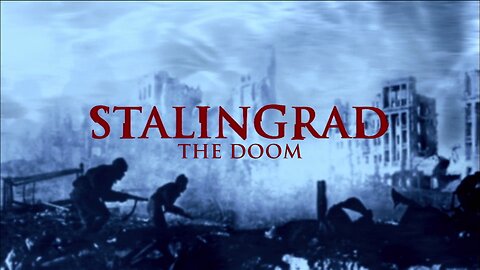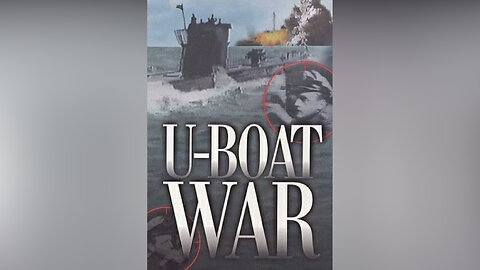
-
U-Boat War: Sea Wolves (Episode 1)
 Adaneth - History&PoliticsA 2001 ITN/Discovery Channel History, War Documentary. In World War II, lethal German U-Boats sailed all over the world wreaking havoc and destruction. This unique DVD charts the true, close-run fight that took place. With rare, original footage of actual battle scenes and interviews with U-Boat commanders and crew members from both the Allied and Axis naval forces, these three programs give the viewer an inside look at the destructive nature of these deadly "Iron Coffins". Episode 1: U-Boats were active from the first day of the war to the last. The menace provoked Winston Churchill to write, "The threat the U-Boats posed in the Atlantic was the only thing that really frightened me during the war. On their defeat hung the outcome of World War II." Witness the actions of the famed Wolf Packs in this riveting episode. Episode 2: https://rumble.com/v67ckss-u-boat-war-attack-america-episode-2.html124 views
Adaneth - History&PoliticsA 2001 ITN/Discovery Channel History, War Documentary. In World War II, lethal German U-Boats sailed all over the world wreaking havoc and destruction. This unique DVD charts the true, close-run fight that took place. With rare, original footage of actual battle scenes and interviews with U-Boat commanders and crew members from both the Allied and Axis naval forces, these three programs give the viewer an inside look at the destructive nature of these deadly "Iron Coffins". Episode 1: U-Boats were active from the first day of the war to the last. The menace provoked Winston Churchill to write, "The threat the U-Boats posed in the Atlantic was the only thing that really frightened me during the war. On their defeat hung the outcome of World War II." Witness the actions of the famed Wolf Packs in this riveting episode. Episode 2: https://rumble.com/v67ckss-u-boat-war-attack-america-episode-2.html124 views -
U-Boat War: Attack America (Episode 2)
 Adaneth - History&PoliticsEpisode 2: From New York to Florida, Americans were unaware that just a few miles off their shores, Hitler's U-Boats lurked ready to strike against their country. The German U-Boat fleet terrorized American coastal waters and vessel after vessel went down in one of the greatest maritime disasters of all time. Episode 3: https://rumble.com/v67ct7a-u-boat-war-iron-coffins-episode-3.html51 views
Adaneth - History&PoliticsEpisode 2: From New York to Florida, Americans were unaware that just a few miles off their shores, Hitler's U-Boats lurked ready to strike against their country. The German U-Boat fleet terrorized American coastal waters and vessel after vessel went down in one of the greatest maritime disasters of all time. Episode 3: https://rumble.com/v67ct7a-u-boat-war-iron-coffins-episode-3.html51 views -
U-Boat War: Iron Coffins (Episode 3)
 Adaneth - History&PoliticsEpisode 3: The largest U-Boat housed 44 crew members who lived in their weapons of war for days on end in cramped and squalid conditions. Of the 38,000 men who fought in these machines during World War II, 30,000 would die in their iron coffins. Experience the Allied strategies and tactics of 1943 that caused the men in the U-Boats to suffer the highest mortality rate of any fighting unit in the history of war.68 views
Adaneth - History&PoliticsEpisode 3: The largest U-Boat housed 44 crew members who lived in their weapons of war for days on end in cramped and squalid conditions. Of the 38,000 men who fought in these machines during World War II, 30,000 would die in their iron coffins. Experience the Allied strategies and tactics of 1943 that caused the men in the U-Boats to suffer the highest mortality rate of any fighting unit in the history of war.68 views -
Battle for Norway – 1940 Campaign/Kampf um Norwegen - Feldzug 1940
 Adaneth - History&PoliticsKampf um Norwegen – Feldzug 1940 is a 1940 Nazi propaganda film directed by Martin Rikli and Dr. Werner Buhre, narrated by Harry Giese. The film is produced by the Oberkommando Wehrmacht (OKW) and Die Universum Film AG (UFA). Audio in German with English subtitles. Introduction by historian Guri Hjeltnes. Germany's surprise invasion of Denmark and Norway in April 1940 witnessed heavy fighting on land and at sea, and the first confrontation of the war against Anglo-French forces. Berlin's 1940 cinematic record of the campaign incorporated footage shot by German combat correspondents, animated maps, and scenes from captured Allied newsreels to present a dramatic, comprehensive chronology of the fighting. The German army's rapid seizure of Copenhagen and Oslo, and the infantry's advance across mountainous terrain defended by Norwegian ski troops, define the struggles for Denmark and central Norway. The film's editors blended Allied documentation of naval engagements off Norway's coast with German footage, offering a riveting account of the battles as seen by the men of both navies. The Germans' tenacious defense of Narvik against elite French troops highlights the full-length feature. The film was shown only internally for the three branches of the German armed forces, although it was a feature film designed for the general audience. It was shelved for unknown reasons, perhaps only because the topic was no longer top priority. Believed lost, a brilliant print surfaced in auction 2005 , and was preserved by the Norsk Filminstitutt and the Bundesarchiv-Filmarchiv.99 views
Adaneth - History&PoliticsKampf um Norwegen – Feldzug 1940 is a 1940 Nazi propaganda film directed by Martin Rikli and Dr. Werner Buhre, narrated by Harry Giese. The film is produced by the Oberkommando Wehrmacht (OKW) and Die Universum Film AG (UFA). Audio in German with English subtitles. Introduction by historian Guri Hjeltnes. Germany's surprise invasion of Denmark and Norway in April 1940 witnessed heavy fighting on land and at sea, and the first confrontation of the war against Anglo-French forces. Berlin's 1940 cinematic record of the campaign incorporated footage shot by German combat correspondents, animated maps, and scenes from captured Allied newsreels to present a dramatic, comprehensive chronology of the fighting. The German army's rapid seizure of Copenhagen and Oslo, and the infantry's advance across mountainous terrain defended by Norwegian ski troops, define the struggles for Denmark and central Norway. The film's editors blended Allied documentation of naval engagements off Norway's coast with German footage, offering a riveting account of the battles as seen by the men of both navies. The Germans' tenacious defense of Narvik against elite French troops highlights the full-length feature. The film was shown only internally for the three branches of the German armed forces, although it was a feature film designed for the general audience. It was shelved for unknown reasons, perhaps only because the topic was no longer top priority. Believed lost, a brilliant print surfaced in auction 2005 , and was preserved by the Norsk Filminstitutt and the Bundesarchiv-Filmarchiv.99 views -
Stalingrad: The Attack (Part 1)
 Adaneth - History&PoliticsA 2003 War Documentary narrated by Joachim Hoeppner. Hardly any event in the entire history of war has made such a traumatic impression on the German consciousness as did the catastrophe on the Volga in 1942/43: 60 years ago Stalingrad became a mass grave of the German Wehrmacht and a psychological turning point of the Second World War. The Eastern Front experienced the viciousness of war on a scale of unimaginable horror and brutality. The bloodiest and most savage fighting took place in Stalingrad between August 1942 and February 1943. Stalin's city on the Volga had military significance for Hitler, as it carried the name of his enemy and therefore had to be destroyed. The ensuing battle sealed the fates of hundreds of thousands of soldiers and civilians, marked the turning point of World War II, and was the beginning of the end for Nazi Germany. This three-part documentary by award-winning documentary filmmakers Sebastian Dehnhardt, Christian Deick and Jorg Mullner under the direction of Guido Knopp presents both the German and Russian perspective, contains rare footage shot by soldiers during the siege, and reveals new historical facts with moving eyewitness accounts and confessions from some of Stalingrad's last survivors. The Russian archives opened their doors to the filmmakers, granting exclusive access to a wealth of previously unreleased material. The battle for Stalingrad, in which at least one million German soldiers, Red Army soldiers and Soviet civilians fell victim, was the bloodiest decisive battle in the 'war of extermination' unleashed by Hitler. Like a shock, the catastrophe of the 6th Army made it clear to many Germans that, despite all the propaganda chants, the war would be lost. For Germans and Russians, Stalingrad marked the psychological turning point in the Second World War. How the catastrophe came about and what cruel consequences the battle had for the soldiers and inhabitants of the city are described in the series with many previously unpublished film recordings and unsparing eyewitness testimonies from survivors on both sides. Former soldiers of the 6th Army and their former opponents describe - because of their age probably last time - moments that shaped their life: snipers tell on murderous hunts in the ruined world of Stalingrad, where one wrong move could kill, but also civilians make harrowing confessions. The once enemy nations are now showing what was going on and really happened in the inferno of Stalingrad in a joint television production. In cooperation with the Russian television station TVS, a documentary was created to broadcast simultaneously on German and Russian television. Part 1: With a force of over half a million men, the German army advanced towards the Caspian Sea and Stalingrad to capture the center of Soviet military industry. Hitler's Sixth Army faced strong resistance from all sides and German soldiers perished in bloody battles. Yet Hitler still boasted on November 8th in Munich that Stalingrad was practically conquered and the Germans would never leave the city again. With the dimensions of Russia in mind, the rapid advance of the German army to the Volga - measured against the low population density - was not an ultimate achievement. It was much more difficult to ensure sufficient supplies. However, the German army command had not reckoned with the continental winter and the tough and clever resistance of the defenders. Red Army soldiers fiercely defended every house, every basement, every shelter. In mid-November 1942, the attackers were surrounded by a surprising Soviet counter-offensive. It was the beginning of the end of the 6th Army. Part 2: https://rumble.com/v29l8za-stalingrad-the-kessel-part-2.html895 views 4 comments
Adaneth - History&PoliticsA 2003 War Documentary narrated by Joachim Hoeppner. Hardly any event in the entire history of war has made such a traumatic impression on the German consciousness as did the catastrophe on the Volga in 1942/43: 60 years ago Stalingrad became a mass grave of the German Wehrmacht and a psychological turning point of the Second World War. The Eastern Front experienced the viciousness of war on a scale of unimaginable horror and brutality. The bloodiest and most savage fighting took place in Stalingrad between August 1942 and February 1943. Stalin's city on the Volga had military significance for Hitler, as it carried the name of his enemy and therefore had to be destroyed. The ensuing battle sealed the fates of hundreds of thousands of soldiers and civilians, marked the turning point of World War II, and was the beginning of the end for Nazi Germany. This three-part documentary by award-winning documentary filmmakers Sebastian Dehnhardt, Christian Deick and Jorg Mullner under the direction of Guido Knopp presents both the German and Russian perspective, contains rare footage shot by soldiers during the siege, and reveals new historical facts with moving eyewitness accounts and confessions from some of Stalingrad's last survivors. The Russian archives opened their doors to the filmmakers, granting exclusive access to a wealth of previously unreleased material. The battle for Stalingrad, in which at least one million German soldiers, Red Army soldiers and Soviet civilians fell victim, was the bloodiest decisive battle in the 'war of extermination' unleashed by Hitler. Like a shock, the catastrophe of the 6th Army made it clear to many Germans that, despite all the propaganda chants, the war would be lost. For Germans and Russians, Stalingrad marked the psychological turning point in the Second World War. How the catastrophe came about and what cruel consequences the battle had for the soldiers and inhabitants of the city are described in the series with many previously unpublished film recordings and unsparing eyewitness testimonies from survivors on both sides. Former soldiers of the 6th Army and their former opponents describe - because of their age probably last time - moments that shaped their life: snipers tell on murderous hunts in the ruined world of Stalingrad, where one wrong move could kill, but also civilians make harrowing confessions. The once enemy nations are now showing what was going on and really happened in the inferno of Stalingrad in a joint television production. In cooperation with the Russian television station TVS, a documentary was created to broadcast simultaneously on German and Russian television. Part 1: With a force of over half a million men, the German army advanced towards the Caspian Sea and Stalingrad to capture the center of Soviet military industry. Hitler's Sixth Army faced strong resistance from all sides and German soldiers perished in bloody battles. Yet Hitler still boasted on November 8th in Munich that Stalingrad was practically conquered and the Germans would never leave the city again. With the dimensions of Russia in mind, the rapid advance of the German army to the Volga - measured against the low population density - was not an ultimate achievement. It was much more difficult to ensure sufficient supplies. However, the German army command had not reckoned with the continental winter and the tough and clever resistance of the defenders. Red Army soldiers fiercely defended every house, every basement, every shelter. In mid-November 1942, the attackers were surrounded by a surprising Soviet counter-offensive. It was the beginning of the end of the 6th Army. Part 2: https://rumble.com/v29l8za-stalingrad-the-kessel-part-2.html895 views 4 comments -
Stalingrad: The Kessel (Part 2)
 Adaneth - History&PoliticsEpisode 2: In the early morning of November 19, 1942, one of the most moving chapters of World War II began. A dense fog lay in the lowlands between the Don and the Volga. At 5:20 a.m., several thousand Soviet guns and Stalin organs opened fire. "It was breathtaking," Captain Gerard Dengler recalls with a shudder. The Soviet attack hit the Germans at their most vulnerable point: in the rear of the front, where allied Romanians and Italians secured the flanks of the 6th Army. Their resistance didn't last long. Poorly equipped and doubting the sense of the campaign, the units of the "allies" surrendered to the overwhelming superiority. The Soviet armored spearheads, who had attacked simultaneously from the north and south, met at Kalach. The German 6th Army with more than 300,000 men was surrounded. By November 23, Russian forces had encircled the Germans; 300,000 soldiers were trapped. Hitler monitored the situation elsewhere and did not give the order to retreat against the advice of the experts. Goering promised to try to drop aid packages, ammunition and fuel from the air, but the attempt failed. The temperature dropped quickly to -40 degrees, and the German soldiers in summer clothes had no chance in the Russian winter. Christmas during the blockade was a time of extreme despair for men. Part 3: https://rumble.com/v29lbie-stalingrad-the-doom-part-3.html166 views
Adaneth - History&PoliticsEpisode 2: In the early morning of November 19, 1942, one of the most moving chapters of World War II began. A dense fog lay in the lowlands between the Don and the Volga. At 5:20 a.m., several thousand Soviet guns and Stalin organs opened fire. "It was breathtaking," Captain Gerard Dengler recalls with a shudder. The Soviet attack hit the Germans at their most vulnerable point: in the rear of the front, where allied Romanians and Italians secured the flanks of the 6th Army. Their resistance didn't last long. Poorly equipped and doubting the sense of the campaign, the units of the "allies" surrendered to the overwhelming superiority. The Soviet armored spearheads, who had attacked simultaneously from the north and south, met at Kalach. The German 6th Army with more than 300,000 men was surrounded. By November 23, Russian forces had encircled the Germans; 300,000 soldiers were trapped. Hitler monitored the situation elsewhere and did not give the order to retreat against the advice of the experts. Goering promised to try to drop aid packages, ammunition and fuel from the air, but the attempt failed. The temperature dropped quickly to -40 degrees, and the German soldiers in summer clothes had no chance in the Russian winter. Christmas during the blockade was a time of extreme despair for men. Part 3: https://rumble.com/v29lbie-stalingrad-the-doom-part-3.html166 views -
Stalingrad: The Doom (Part 3)
 Adaneth - History&PoliticsPart 3: At the beginning of January 1943, the situation for the soldiers of the 6th Army was hopeless: completely exhausted, half starved and apathetic, the men lay in their positions in freezing temperatures. They can no longer defend themselves, the ammunition is almost gone. Then, on January 8, 1943, the Soviets offered the Sixth Army honorable terms of surrender. But Hitler forbids Paulus to give up the fight. The senseless death goes on. "The Sixth Army has my word that everything possible will be done to save you. Adolf Hitler." The radio message reached the besieged soldiers on January 31, 1942. Two days later, the last units surrendered. Hitler was furious. Never before had German army commanders been captured. About 95,000 soldiers were captured and only 6,000 returned home.134 views
Adaneth - History&PoliticsPart 3: At the beginning of January 1943, the situation for the soldiers of the 6th Army was hopeless: completely exhausted, half starved and apathetic, the men lay in their positions in freezing temperatures. They can no longer defend themselves, the ammunition is almost gone. Then, on January 8, 1943, the Soviets offered the Sixth Army honorable terms of surrender. But Hitler forbids Paulus to give up the fight. The senseless death goes on. "The Sixth Army has my word that everything possible will be done to save you. Adolf Hitler." The radio message reached the besieged soldiers on January 31, 1942. Two days later, the last units surrendered. Hitler was furious. Never before had German army commanders been captured. About 95,000 soldiers were captured and only 6,000 returned home.134 views
